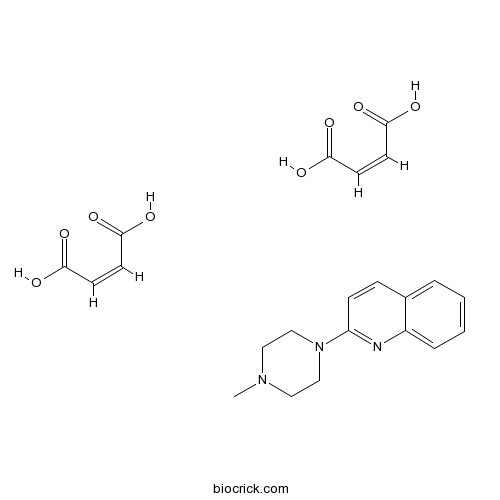N-Methylquipazine dimaleate5-HT3 agonist CAS# 171205-17-7 |

- SU14813
Catalog No.:BCC1971
CAS No.:627908-92-3
Quality Control & MSDS
3D structure
Package In Stock
Number of papers citing our products

| Cas No. | 171205-17-7 | SDF | Download SDF |
| PubChem ID | 11957670 | Appearance | Powder |
| Formula | C22H25N3O8 | M.Wt | 459.45 |
| Type of Compound | N/A | Storage | Desiccate at -20°C |
| Solubility | Soluble to 50 mM in water | ||
| Chemical Name | (Z)-but-2-enedioic acid;2-(4-methylpiperazin-1-yl)quinoline | ||
| SMILES | CN1CCN(CC1)C2=NC3=CC=CC=C3C=C2.C(=CC(=O)O)C(=O)O.C(=CC(=O)O)C(=O)O | ||
| Standard InChIKey | HNSITEGFVDCKMF-SPIKMXEPSA-N | ||
| Standard InChI | InChI=1S/C14H17N3.2C4H4O4/c1-16-8-10-17(11-9-16)14-7-6-12-4-2-3-5-13(12)15-14;2*5-3(6)1-2-4(7)8/h2-7H,8-11H2,1H3;2*1-2H,(H,5,6)(H,7,8)/b;2*2-1- | ||
| General tips | For obtaining a higher solubility , please warm the tube at 37 ℃ and shake it in the ultrasonic bath for a while.Stock solution can be stored below -20℃ for several months. We recommend that you prepare and use the solution on the same day. However, if the test schedule requires, the stock solutions can be prepared in advance, and the stock solution must be sealed and stored below -20℃. In general, the stock solution can be kept for several months. Before use, we recommend that you leave the vial at room temperature for at least an hour before opening it. |
||
| About Packaging | 1. The packaging of the product may be reversed during transportation, cause the high purity compounds to adhere to the neck or cap of the vial.Take the vail out of its packaging and shake gently until the compounds fall to the bottom of the vial. 2. For liquid products, please centrifuge at 500xg to gather the liquid to the bottom of the vial. 3. Try to avoid loss or contamination during the experiment. |
||
| Shipping Condition | Packaging according to customer requirements(5mg, 10mg, 20mg and more). Ship via FedEx, DHL, UPS, EMS or other couriers with RT, or blue ice upon request. | ||
| Description | 5-HT3 agonist. Has almost the same affinity for 5-HT3 sites as quipazine but unlike the latter, does not bind to 5-HT1B sites. |

N-Methylquipazine dimaleate Dilution Calculator

N-Methylquipazine dimaleate Molarity Calculator
| 1 mg | 5 mg | 10 mg | 20 mg | 25 mg | |
| 1 mM | 2.1765 mL | 10.8826 mL | 21.7652 mL | 43.5303 mL | 54.4129 mL |
| 5 mM | 0.4353 mL | 2.1765 mL | 4.353 mL | 8.7061 mL | 10.8826 mL |
| 10 mM | 0.2177 mL | 1.0883 mL | 2.1765 mL | 4.353 mL | 5.4413 mL |
| 50 mM | 0.0435 mL | 0.2177 mL | 0.4353 mL | 0.8706 mL | 1.0883 mL |
| 100 mM | 0.0218 mL | 0.1088 mL | 0.2177 mL | 0.4353 mL | 0.5441 mL |
| * Note: If you are in the process of experiment, it's necessary to make the dilution ratios of the samples. The dilution data above is only for reference. Normally, it's can get a better solubility within lower of Concentrations. | |||||

Calcutta University

University of Minnesota

University of Maryland School of Medicine

University of Illinois at Chicago

The Ohio State University

University of Zurich

Harvard University

Colorado State University

Auburn University

Yale University

Worcester Polytechnic Institute

Washington State University

Stanford University

University of Leipzig

Universidade da Beira Interior

The Institute of Cancer Research

Heidelberg University

University of Amsterdam

University of Auckland

TsingHua University

The University of Michigan

Miami University

DRURY University

Jilin University

Fudan University

Wuhan University

Sun Yat-sen University

Universite de Paris

Deemed University

Auckland University

The University of Tokyo

Korea University
- PD 158780
Catalog No.:BCC7434
CAS No.:171179-06-9
- H-Ser(tBu)-OMe.HCl
Catalog No.:BCC3033
CAS No.:17114-97-5
- EGLU
Catalog No.:BCC6871
CAS No.:170984-72-2
- Tetrindole mesylate
Catalog No.:BCC6763
CAS No.:170964-68-8
- Dihydroactinidiolide
Catalog No.:BCN6890
CAS No.:17092-92-1
- Donitriptan hydrochloride
Catalog No.:BCC7742
CAS No.:170911-68-9
- Aburatubolactam A
Catalog No.:BCN1821
CAS No.:170894-24-3
- Persianone
Catalog No.:BCN7359
CAS No.:170894-20-9
- Cyasterone
Catalog No.:BCN5416
CAS No.:17086-76-9
- Sonepiprazole
Catalog No.:BCC7879
CAS No.:170858-33-0
- PNU 96415E
Catalog No.:BCC7467
CAS No.:170856-41-4
- (RS)-APICA
Catalog No.:BCC6925
CAS No.:170847-18-4
- Posaconazole
Catalog No.:BCC1103
CAS No.:171228-49-2
- TAPI-1
Catalog No.:BCC5400
CAS No.:171235-71-5
- (RS)-AMPA hydrobromide
Catalog No.:BCC6926
CAS No.:171259-81-7
- Delphinidin-3-O-arabinoside chloride
Catalog No.:BCN3021
CAS No.:171370-55-1
- Ethyl 4-hydroxyphenylacetate
Catalog No.:BCN3792
CAS No.:17138-28-2
- Calcium Gluceptate
Catalog No.:BCC3743
CAS No.:17140-60-2
- Otophylloside B 4'''-O-alpha-L-cymaropyranoside
Catalog No.:BCN7511
CAS No.:171422-82-5
- Otophylloside B 4'''-O-beta-D-cymaropyranoside
Catalog No.:BCN7522
CAS No.:171422-85-8
- SLIGRL-NH2
Catalog No.:BCC3947
CAS No.:171436-38-7
- Dammarenediol II 3-O-caffeate
Catalog No.:BCN6519
CAS No.:171438-55-4
- Salprionin
Catalog No.:BCN3162
CAS No.:171439-43-3
- Myrislignan
Catalog No.:BCN1242
CAS No.:171485-39-5
Binding of arylpiperazines to 5-HT3 serotonin receptors: results of a structure-affinity study.[Pubmed:2583244]
Eur J Pharmacol. 1989 Sep 22;168(3):387-92.
The binding affinities of a series of arylpiperazine derivatives at [3H]quipazine-labeled central 5-HT3 sites were investigated. Features determined to be important for binding include the N4 piperazine nitrogen atom (but not the N1 piperazine nitrogen), and a quinolinyl group. The quinoline nitrogen atom of quipazine also contributes to affinity and its replacement by carbon reduces affinity by 20-fold. The entire quinoline nucleus is not necessary for binding, and certain monocyclic arylpiperazines, particularly those with a chloro group meta to the position of the piperazine ring (e.g. mCPP, MK-212), also bind at 5-HT3, sites; however, the affinities of these agents are at least an order of magnitude less than that of quipazine itself. Taking advantage of the fact that tertiary amines are not well tolerated at 5-HT1B sites, but that N-methyl substituents have little effect on 5-HT3 binding, we designed and synthesized a tertiary amine analog of quipazine, i.e., N-methylquipazine (NMQ). NMQ binds at 5-HT3 sites with an affinity similar to that of quipazine; however, unlike quipazine, NMQ shows very little affinity (IC50 greater than 10,000 nM) for central 5-HT1B sites.


